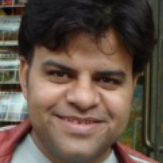
Pawan Kumar Dahiya
Work place: Department of Electronics & Communication Engineering, DCRUST, Murthal, Sonepat, India
E-mail: pawan.dahiya@gmail.com
Website:
Research Interests: Algorithm Design, Database Management System, Computing Platform, Embedded System
Biography
Dr. Pawan Kumar Dahiya received his Ph.D degree in ECE. He is working as an Assistant Professor in ECE Deptt., in DCRUST, Murthal, Haryana, India. His research areas are Digital and Embedded System Design, ANPR, VANETs, Soft Computing Techniques, Image Processing, Internet of Things (IoT), etc. He has more than 50 publications in various national and international reputed journals.
Author Articles
A Genesis of a Meticulous Fusion based Color Descriptor to Analyze the Supremacy between Machine Learning and Deep Learning
By Shikha Bhardwaj Gitanjali Pandove Pawan Kumar Dahiya
DOI: https://doi.org/10.5815/ijisa.2020.02.03, Pub. Date: 8 Apr. 2020
The tremendous advancements in digital technology pertaining to diverse application areas like medical diagnostics, crime detection, defense etc., has led to an exceptional increase in the multimedia image content. This bears an acute requirement of an effectual retrieval system to cope up with the human demands. Therefore, Content-based image retrieval (CBIR) is among the renowned retrieval systems which uses color, texture, shape, edge and other spatial information to extract the basic image features. This paper proposes an efficient and unexcelled hybrid color descriptor which is an amalgamation of color histogram, color moment and color auto-correlogram. In order to determine the predominance between machine learning and deep learning, two machine learning models, Support vector machine (SVM) and Extreme learning machine (ELM) have been tested. Whereas from deep learning category, Cascade forward back propagation neural network (CFBPNN) and Patternnet have been utilized. Finally, from these divergent tested algorithms, CFBPNN attains the highest accuracy and has been selected to enhance the retrieval accuracy of the proposed system. Numerous standard benchmark datasets namely Corel-1K, Corel-5K, Corel-10K, Oxford flower, Coil-100 and Zurich buildings have been tested here and average precision of 97.1%, 90.3%, 87.9%, 98.4%, 98.9% and 82.7% is obtained respectively which is significantly higher than many state-of-the-art related techniques.
[...] Read more.A Comparative Investigation into Edge Detection Techniques Based on Computational Intelligence
By Naveen Singh Dagar Pawan Kumar Dahiya
DOI: https://doi.org/10.5815/ijigsp.2019.07.05, Pub. Date: 8 Jul. 2019
Soft Computing becomes visible in the field of computer science. The soft computing (SC) comprises of several basic methods such as Fuzzy logic (FL), Evolutionary Computation (EC) and Machine Learning (ML). Soft computing has many real-world applications in domestic, commercial and industrial situations. Edge detection in image processing is the most important applications where soft computing becomes popular. Edge detection decreases the measure of information and filters out undesirable information and gives the desirable information in an image. In image processing edge detection is a fundamental step. For this, high level Computational Intelligence based edge detections methods are required for different images. Computational Intelligence deals with ambiguous and low cost solution. The mind of the human is the key factor of the soft computing. In this paper, we included Binary particle Swarm Optimization (BPSO), Distinct Particle Swarm Optimization (DPSO), Genetic Algorithm (GA) and Ant Colony optimization (ACO) techniques. The ground truth images are taken as reference edge images and all the edge images acquired by different computational intelligent techniques for edge detection systems are contrasted with reference edge image with ascertain the Precision, Recall and F-Score. The techniques are tested on 100 test images from the BSD500 datasets. Experimental results show that the BPSO provides promising results in comparison with the other techniques such as DPSO, GA and ACO.
[...] Read more.Other Articles
Subscribe to receive issue release notifications and newsletters from MECS Press journals